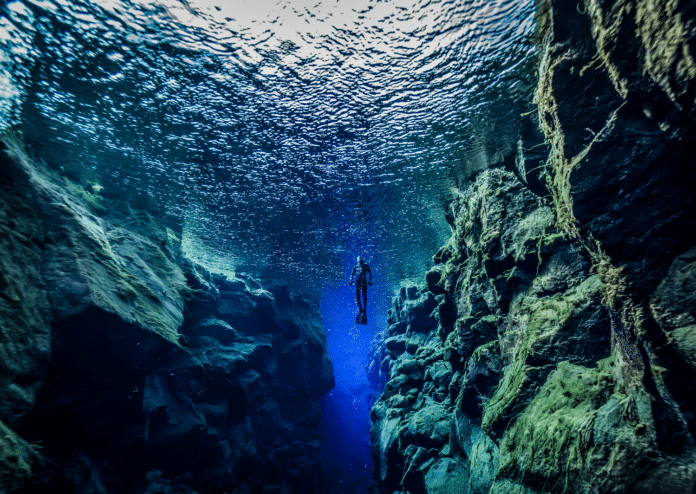If you find yourself tiring of your local dive spot – or worse, feeling a little jaded with the sport in general – consider booking a trip to one of these extraordinary dive sites. Some are suitable for beginners while others are strictly for advanced divers only, but all of them offer a truly unique experience guaranteed to get you out of your scuba rut. From muddy rivers full of prehistoric fossils to underwater museums adorned by man-made sculptures, let this article inform your new and improved diving bucket list.
Museo Subacuático de Arte, Mexico
In 2009, the waters around Cancun, Isla Mujeres, and Punta Nizuc were transformed by the installation of an underwater sculpture museum. The museum, which covers approximately 420 square meters of the previously barren seafloor, now includes over 500 life-sized statues created by British sculptor Jason deCaires Taylor. Made from environmentally friendly concrete, the statues provide the perfect surface for new corals to grow and thrive. Some of them double as lobster hatcheries or fish nurseries, and together, they represent the connection between mankind and the sea.
The museum is divided into two sections – one exclusively for snorkelers, and one for scuba divers. The scuba section, which is known as Salon Manchones, has a maximum depth of eight meters and includes famous sculptures like Man on Fire, The Dream Collector, and The Silent Evolution. The latter comprises over 400 individual statues cast from members of the local community. Easily accessible with the help of Cancun’s many dive centers, the site’s novelty factor is complemented by warm water temperatures and spectacular visibility.
Dead Sea, Israel
Sandwiched between Jordan, Israel, and Palestine, the Dead Sea is the world’s lowest elevation on land. Known for its incredible salinity (it’s almost 10 times as salty as the ocean), it has been a place of pilgrimage since ancient times and is believed to have healing properties. The water here is so dense that swimmers can float practically unaided; and yet, Israel-based company Dead Sea Divers have found a way to descend beneath the sea’s surface. The trick? Between 40 and 50 kilograms of weight per diver.
Full face masks are also required, and training is included in the price of your dive. As the name suggests, there is no life in the Dead Sea (with the exception of a few hardy bacteria and algae species). What makes this dive worthwhile is the ethereal underwater scenery created by alien-like formations of glittering salt crystals. Everything is covered in a thick coat of white, conjuring up impressions of polar diving – although water temperatures can get as high as 35ºC. Visibility is variable, ranging from 1 to 20 metres.
Cooper River, United States
Diving in South Carolina’s alligator-infested Cooper River is characterised by tearing currents and tannin-rich waters with near-zero visibility. And yet, this high-octane dive destination is one of the best places in the world to search for fossils and historic artefacts. As little as 1.5 million years ago, the region was covered by seawater and inhabited by prehistoric marine animals. When the waters receded, they were replaced by a humid jungle that provided an ideal habitat for cave bears and sabre-toothed tigers.
Human history in the area also dates back thousands of years. Cooper River Diving offers divers the chance to search for pieces of the river’s fascinating history, with possible finds ranging from fossilised whale bones to Native American arrowheads and pottery from colonial plantations. Above all, Cooper River is renowned as a great place to search for megalodon teeth. If you want to keep your treasures, you will need to arrange a Hobby Diver license through the South Carolina Institute of Archaeology and Anthropology.
Silfra, Iceland
The world-famous Silfra fissure is found in Thingvellir National Park, a UNESCO World Heritage Site. It forms part of the divergent tectonic boundary that exists between the Eurasian and North American tectonic plates – a rift that continues to drift apart at a rate of approximately two centimetres every year. Silfra is filled with meltwater from Iceland’s second largest glacier. The water has been filtered through porous rock for between 30 and 100 years, and as a result, it is incredibly clear.
In fact, the freshwater that fills the fissure is so clear that visibility stretches for more than 100 metres. It is also clean enough to drink if you get thirsty on your dive. Above all, though, this spot is special because it’s the only place in the world that allows you to dive directly between two continental plates. There are several sections (including the Silfra Big Crack and the Silfra Cathedral), each with their own unique topography. The maximum depth is 18 meters, while water temperatures can fall as low as 2ºC.
Banua Wuhu Volcano, Indonesia
In between Siau and Sangihe islands in northeastern Indonesia lies the smaller island of Mahengetang, which is in turn home to one of the world’s few diveable active underwater volcanoes. Known as Banua Wuhu, the volcano rises up from 400 meters below sea level to within a few feet of the surface. Although it has no distinct crater, the vast, sulfur-stained rocks that ring its summit emit volcanic gasses that float upwards in a constant stream of silver bubbles. The water around these cracks has an average temperature of 38ºC.
While life in the immediate vicinity of the cracks is limited, the volcano’s slopes are thick with hard and soft corals. The combination of volcanic minerals and nutrients brought into the area by strong currents also provides food for a profusion of marine life. Large schools of pelagic gamefish vie for space with reef residents such as the giant humphead wrasse; while turtles and rays are common. Visit the volcano on a Sulawesi liveaboard, or with regional dive centers like Blue Bay Divers.

